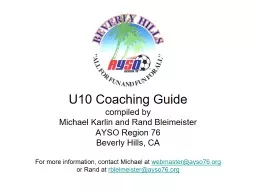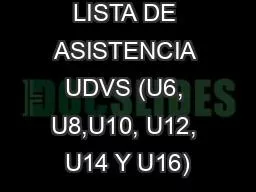PPT-U10 Coaching Guide compiled by
Author : test | Published Date : 2019-12-09
U10 Coaching Guide compiled by Michael Karlin and Rand Bleimeister AYSO Region 76 Beverly Hills CA For more information contact Michael at webmasterayso76org or
Presentation Embed Code
Download Presentation
Download Presentation The PPT/PDF document "U10 Coaching Guide compiled by" is the property of its rightful owner. Permission is granted to download and print the materials on this website for personal, non-commercial use only, and to display it on your personal computer provided you do not modify the materials and that you retain all copyright notices contained in the materials. By downloading content from our website, you accept the terms of this agreement.
U10 Coaching Guide compiled by: Transcript
Download Rules Of Document
"U10 Coaching Guide compiled by"The content belongs to its owner. You may download and print it for personal use, without modification, and keep all copyright notices. By downloading, you agree to these terms.
Related Documents














